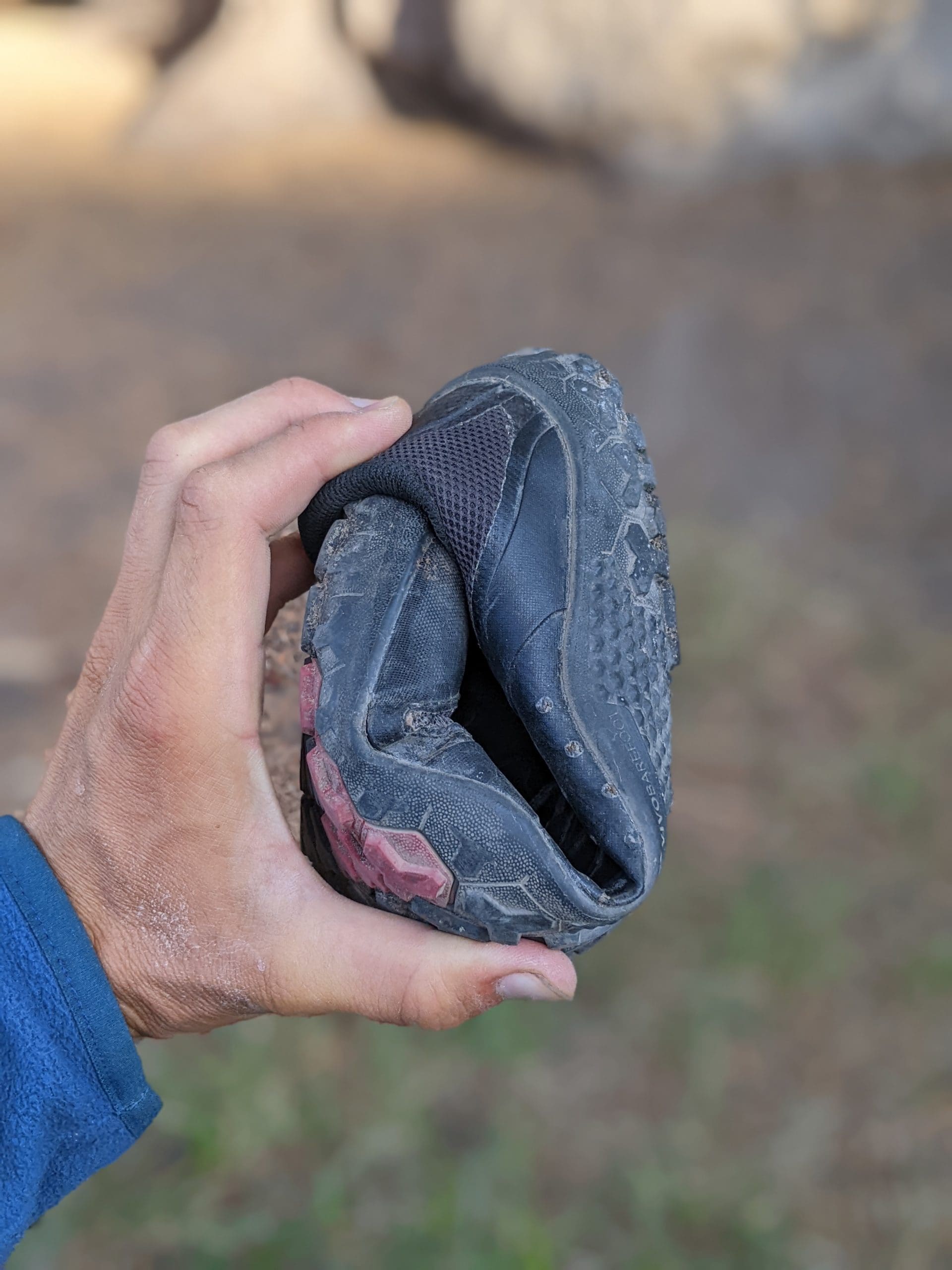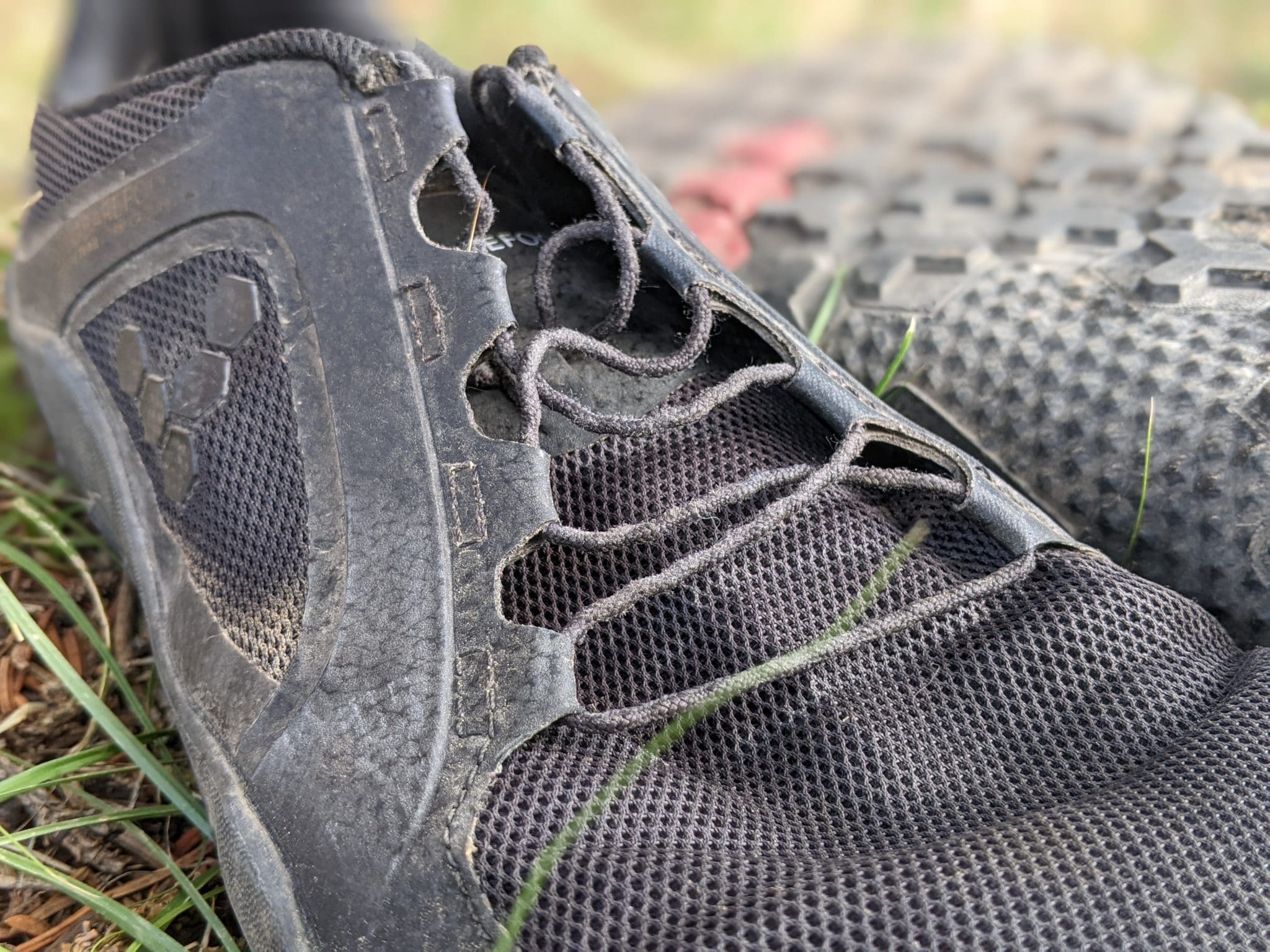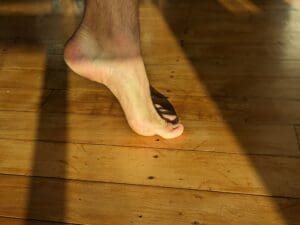Recently, I’ve been mulling over a question I’m sure many of you have.
“Should I race in minimal shoes?”
And if so
“How minimal should I go?”
I decided to do some research and find data to help me answer this question. But to be honest. It’s nonexistent.
The only way I can bring you any good conclusions is to do the testing myself.
And trust me, I will.
But I don’t have my gait analysis sensors with me right now, so the original question is completely unanswered.
Sorry….
BUT
There is a conclusion I did come to. And come to think of it now. The conclusion is obvious.
I’ve not got the best-looking feet in the world right now. I’ve lost way too many toenails and damaged my toes over and over again.
Some of that could be down to the miles I’m doing and imperfections in my running gait. But half of it is certainly down to shoe choice.
My favorite trail running shoe is, hands down, the Xero Shoes Mesa Trail II.

They’re super minimal (for a trail running shoe), uber flexible, and as near to barefoot as you’ll get.
But there’s one drawback.
The Mesa Trail II’s have very little protection.
How often have I kicked a rock in the Mesa Trail II and suffered the consequences later….. Well, my toes tell the story.
And here comes the lesson.
Wear more protective shoes.
Simple eh?
So, how does that translate to shoe selection, especially on race day?
Do you really want a DNF on the books because you kicked a rock so hard you can’t run anymore?
Obviously not.
Which minimal running shoe is for you?
Take a quick 5-question quiz to identify the perfect minimal running shoe for your feet! You'll get both road and trail options based on your answers!
So the key question is: how important is it to be near barefoot, specifically in a race situation where cut off times, PRs, or podium finishes matter?
Originally, when I was thinking about this question, I was contemplating the possibility that a more minimal shoe could reduce the impact forces.
As long as I’m strong enough in the feet and ankles, reducing the impact forces could be beneficial towards the end of the race.
But what’s the use if that same minimal shoe causes an injury or even an uncomfortable niggle because there was not enough protection underfoot or in the toebox?
And considering this issue only becomes more apparent towards the end of a long race when you’re tired and clumsy, the further you run, the more conservative you should be.
So, in the same way you want to reduce blister risk as much as possible –because that can seriously jeopardize your race– you also want to do as much as possible to protect the feet from bruising and impacts that could end your race.

Vivobarefoot Primus Trail
Now that I’ve come to the “protective” conclusion, I’ll be using the Vivobarefoot Primus Trail a lot more for my longer runs.
The outsole is stiffer and reduces the impact of stones and rocks underfoot while still being minimal and offering ground feel.
Also, the toe bumper is more solid than anything you’d see on Xero Shoes models and many Altras, so if you kick any rocks, you might save your race!

Xero Shoes Scrambler Low
The Scrambler Low isn’t exactly a super minimal shoe. Coming in a 10mm and an insole that’s 3mm, its stack height is somewhere between minimal and Altra.
But that extra stack height is why it made this list.
I ran a 100km race in the English Lake District and was super happy with the shoe’s performance.
Towards the end of the race, I still hit many rocky sections in the dark. And while I wasn’t moving too fast, that extract protection underfoot saved me from making a silly mistake and bruising my heel or forefoot.
It’s worth noting, though, the upper protection is poor. The toe bumper is soft, and the material upper is very pliable. You’ll still feel it if you kick or scrape against any rocks.
You can check out my full review if you want to learn more about the Scrambler Low.

Altra Superior 6
This is one of my perfect race day shoes. But yet, I’ve never raced in it. That may change in the future.
Coming in at 21mm, it’s a stacked shoe. Again, that helps with protection and allows you to move faster over tough terrain.
Now, you have to balance that with extra impact forces that’ll naturally occur with using a higher cushioned shoe, but this may not be an issue if this is your race day shoe.
The toe bumper on the Superior 6 is more protective than previous models, and while the fit is snug, I replaced the insole with a thinner option and still made it work for me.
So, does this mean Nick will no longer be running in minimal trail shoes?
Of course not!
My 3-hour run today was still in a wrecked pair of Mesa Trail IIs! 🙂
There’s still a place for training in such shoes, especially when the terrain will be mellow, and the trails are smoothed out.
But if you’re making a race-day shoe decision, I’d take a cautious approach and go for something more protective.
Again, you don’t want to DNF because of a poor shoe choice.




Hi Nick,
Great post – and a topic I am thinking about quite a lote these days. I believe strongly you should use in a race what you use for training. Me for example, I am doing most of my trainings in very minimal shoes like the Vapor Glove or HFS (without insole). While the Superior is still a “mostly minimal shoe” I feel I am overstriding ever so slightly and if feels clumsy. But would I be able to run a long race in the mountains with the Vapor Glove? Maybe I could but it wouldn´t be my fastest option. I came up to the conclusion, I will still use the “very minimal shoes” for my regular runs during the week (which range from 60 – 90 minutes) but do the weekly long run in the mountains with the shoe I´m going to race in. Which will be the Merrell Trail Glove which is still a minimal shoe but offers far more protection but not too much that I feel it alters my gait.
(by the way, I know you don´t like this shoe too much. Getting the fit right is crucial, you need to size up. Which means you got enough space for your toes and most of all, the medial side which feels like an akward pronation support becomes a none issue, only supports the fit. I got size 42,5 in Prios but 43,5 in the Trail Glove).
Having said that, I might still find out on race day I got it all wrong with my theory and wish for my Altra´s 🙂
Best wishes Wolfgang